At the beginning of this new year, Wine Lister is prolonging the festive sparkle through a look at the major trends to emerge from our first Champagne report. Wine Lister’s Champagne study analyses a basket of 109 top wines from the world’s premier sparkling region, and includes insight into the major trends of the Champagne market as identified by Wine Lister Founding Members (c.50 key players in the international fine wine trade).
While quality across the board is something to keep us celebrating well in to 2019 (see more on this here), the notable trends could indicate an increase in year-round enjoyment of Champagne. The chart below shows responses to our question, “What are the most important trends in Champagne?” by number of votes.
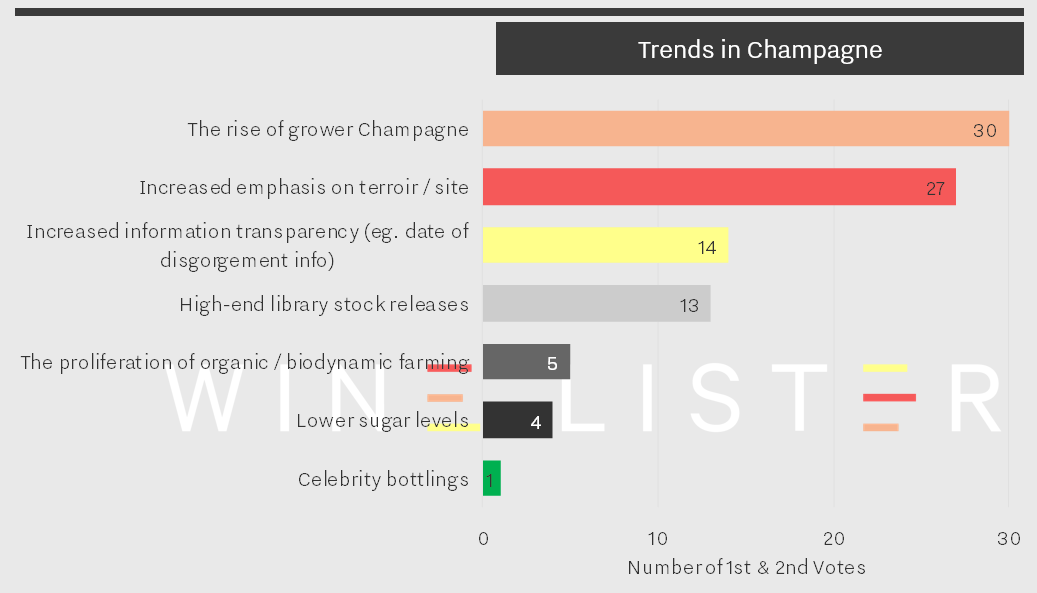
The trend most-frequently ranked as number one or two by Wine Lister Founding Members was the rise of grower Champagnes, closely followed by the increased emphasis on terroir / site Champagnes. One U.K. merchant remarked that “Consumers are now identifying with specific terroir in Champagne and understanding the value of the grower…” – a comment that further leads us to suspect an increased appreciation of Champagnes as wines, and not just celebratory bubbles.
The “rise of the grower” trend is, however, juxtaposed by continued demand for big brands. Of the basket of wines treated in the study, the grower Champagne segment has seen an increase in popularity (measured by search rank) of 9% since the beginning of 2017. Though this performance is superior to the maison segment’s slight decline in popularity (-4%), grower Champagnes still sit twice as far down the popularity rankings, with an average search rank of 1,620 compared to 775.
Perhaps predictably, big brands still win the race when it comes down to the bottom line. A U.K. merchant commented, “Small growers are getting much better press, but I suspect the big name cuvées still rule the roost for sales/investment”. Indeed, when asked to award confidence ratings to specific Champagne producers, the trade cited only one grower champagne within the top two confidence scores (9/10 and 8/10), Jacques Selosse. The houses to earn top confidence ratings were Dom Pérignon, Krug, Louis Roederer, Salon, Bollinger, Pol Roger, and Taittinger, as shown on the chart below.
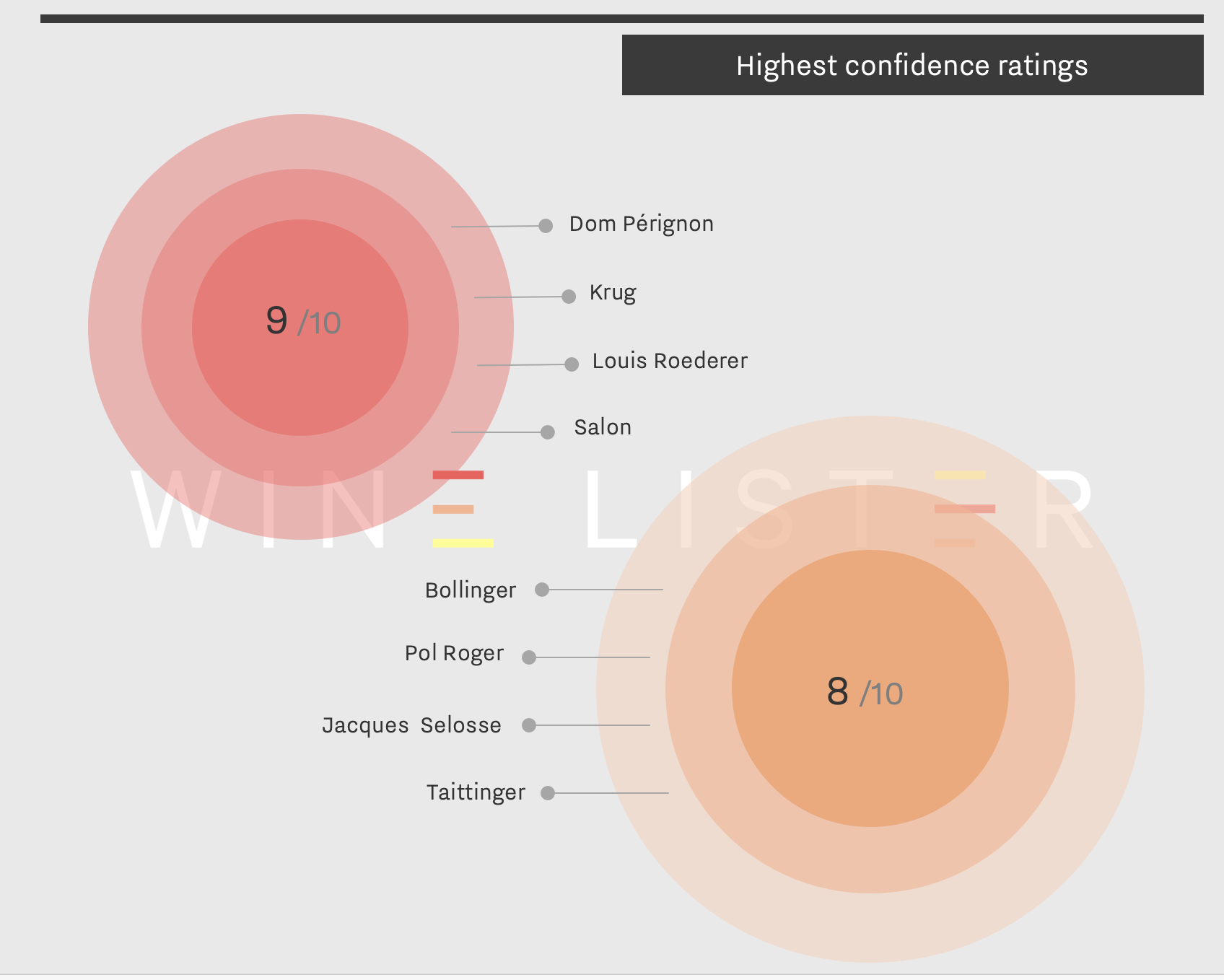
A top tier merchant offers some explanation into the difference in picture painted between the top Champagne trend and Champagne confidence ratings: “Production needs to be small but not so small as to result in a proliferation of Champagnes which the vast majority have never heard of. The big brands which produce great quality are still finding serious demand in the market!”
For a more in-depth look at Champagne, subscribe or log-into read the full report here. Alternatively, all readers can access a five-page executive summary. (Both versions are also available to download in French).
With the festive season fast approaching, what better time to take a look at Wine Lister’s first Champagne study, giving you the inside track on the best Champagnes that money can buy?
The in-depth report covers all angles of this fabled region, from the views of the international trade to all three Wine Lister score categories. In this blog post we drill down to focus on Champagne’s quality. Specifically, here we look at the top 20 Champagnes by Quality score:
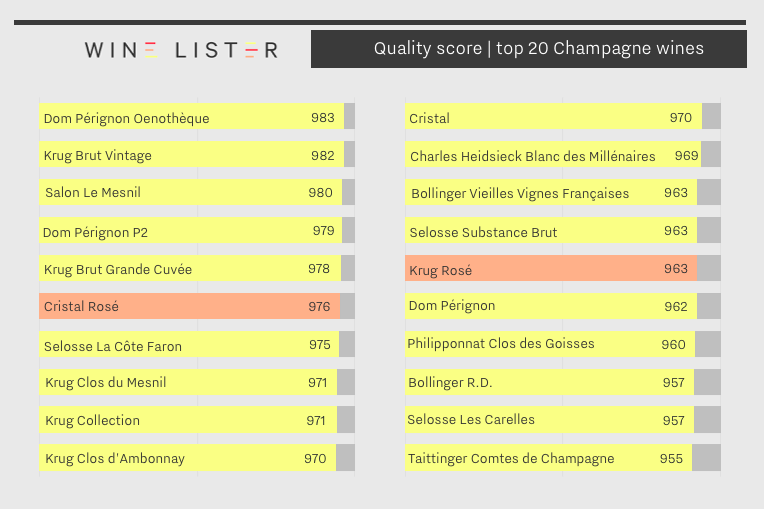
The top maison-led Champagnes dominate the top 20 Champagne Quality scores. Dom Pérignon Oenothèque tops the chart with a score of 983, and its successor (P2) comes in fourth, scoring 979. Krug manages an impressive five wines in the top 10 and six in the top 20, testament to the house’s consistently exceptional quality across its whole range. Krug Brut Vintage is second overall with a score of 982, while Krug Brut Grande Cuvée comes fifth, scoring 978. Krug Clos du Mesnil, Collection, and Clos d’Ambonnay round out the top 10 for Krug.
Salon Le Mesnil, the top scoring Champagne by overall Wine Lister score, comes third for Quality with a score of 982. Cristal Rosé is the highest scoring rosé, coming in sixth place overall with a score of 976, six points ahead of Cristal. Krug Rosé, scoring 963, is the only other rosé to make this top 20.
One of the most important trends identified in Wine Lister’s newly-released study is the rise of grower Champagnes. However, this is nascent enough that only one grower producer threatens the top Champagne houses at the top of the Quality leaderboard. That is cult grower Jacques Selosse, with three wines in the top 20, the same number as Dom Pérignon, trailing only behind Krug. The top wine from Selosse based on Quality score is La Côte Faron, coming in seventh with a score of 975. Substance and Les Carrelles also feature.
Despite the maison-led dominance of the top 20 Quality scores, grower Champagnes win the Quality crown overall. Of the 109 wines included in the study, the 29 grower Champagnes received an average Quality score of 862, while the 80 maison bottlings averaged 853, reflecting the excellent quality that grower Champagne can provide:
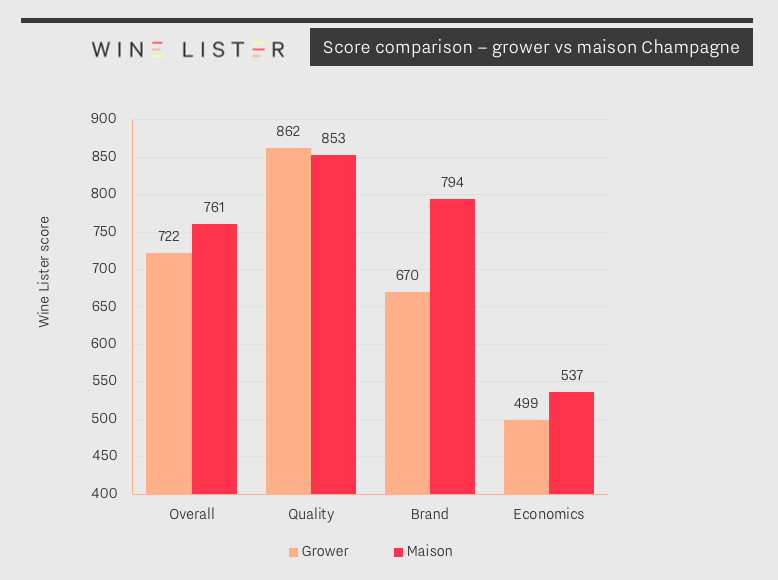
Watch this space for more on grower vs maison Champagnes, and commentary on other major trends featured in the study.
For a more in-depth look at Champagne, subscribe or log-into read the full report here. Alternatively, all readers can access a five-page executive summary. (Both versions are also available to download in French).
Other wines featured in the top 20 Champagnes by Quality score are: Charles Heidsieck Blanc de Millénaires, Bollinger Vieilles Vignes Françaises, Philipponnat Clos des Goisses, Bollinger R.D., and Taittinger Comtes de Champagne.
Our latest Listed blog focused on the top Grand Cru Champagnes by Wine Lister score. As the holiday season approaches, we look at a different kind of ‘top five’ on a sparkling theme – five of the major trends for the Champagne region, determined by a recent survey of Wine Lister’s Founding members.
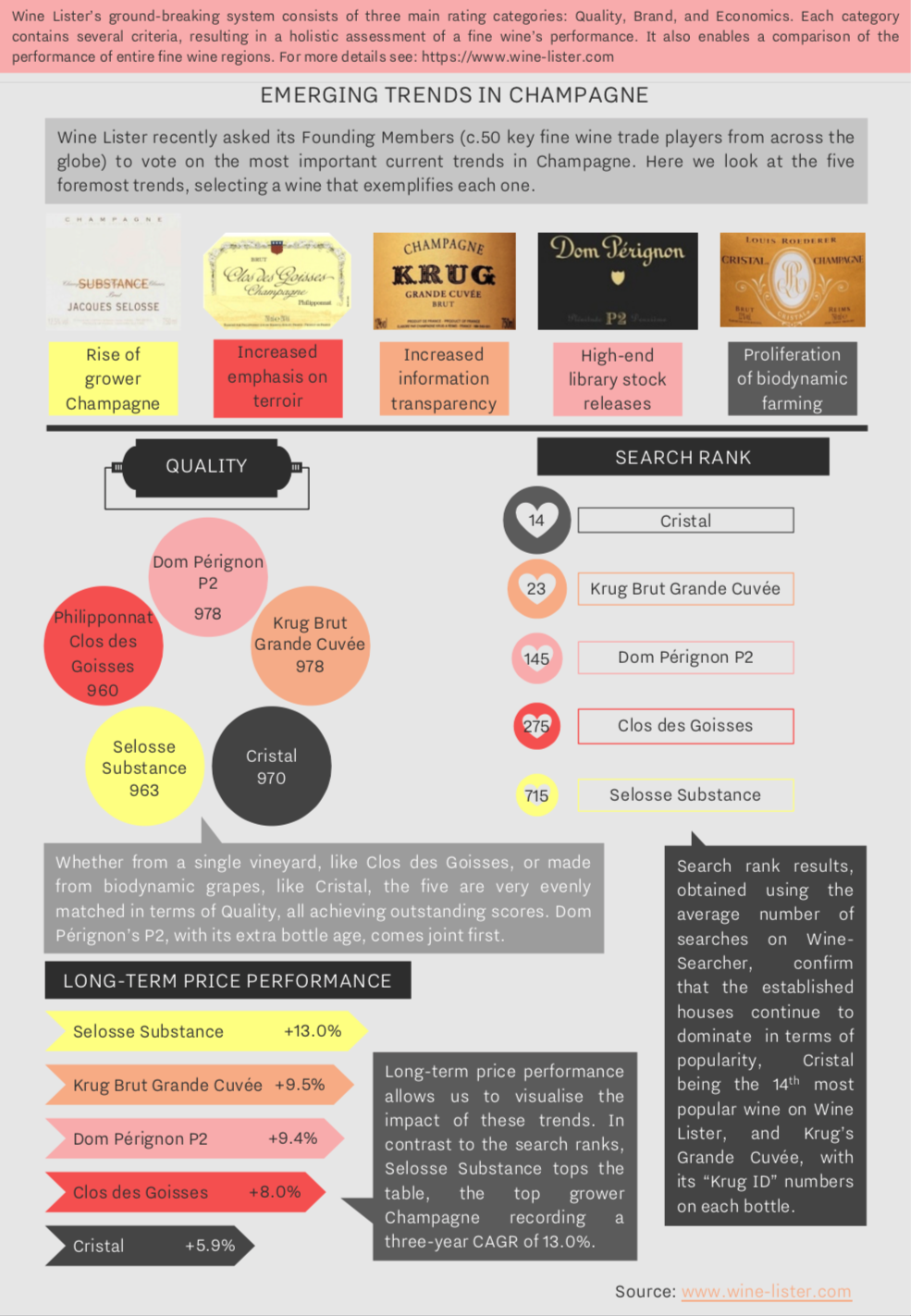
Key members of the global fine wine trade identified the rise of grower Champagnes as an emerging trend. Jacques Selosse reigns supreme, with its Blanc de Noirs La Côte Faron achieving the best Quality score of any grower Champagne on Wine Lister (975). Only an average of 1,250 bottles are produced of this each year – half of the production volume of its Substance Brut.
Founding Members also identified an increased emphasis on terroir as something to look out for. Single vineyard expressions of Champagne are well-known and already extremely sought-after, particularly Krug’s Clos du Mesnil and Clos d’Ambonnay. The latter achieves a Quality score of 970, just 10 points above Philipponnat’s Clos des Goisses, but is over 12 times the price (£1,867 vs. £147).
The phenomenon of increased information transparency is perhaps a sign that buyers are becoming more interested in Champagnes as wines, as opposed to just celebratory bubbles. Krug’s Grande Cuvée has used “Krug ID” numbers since 2011, allowing drinkers to see the vintages, vineyard plots, and grapes included in each bottle. Library releases also cater to more “wine-focused” buyers – Champagne Brand King Dom Perignon’s P2, or Bollinger R.D. are the obvious choices for this.
Finally, interest in biodynamically farmed Champagnes is on the rise, such as Louis Roederer’s Cristal, or any cuvée from Jacques Selosse.
Download a PDF of the slide above here.
First published in French in En Magnum.
Part of Wine Lister’s Brand score includes a measure of prestige, achieved by analysing a wine’s presence in the world’s best restaurants. Whether a restaurant makes the cut depend on a combination of measures including the Michelin Guide, San Pellegrino 50 Best Restaurants, and World of Fine Wine Best Wine List Awards.
The chosen wine lists are then analysed to give us the breadth (how many restaurants) and depth (how many formats and/or vintages in each restaurant) of presence achieved by each wine on Wine Lister. Looking at the former criterion, the chart below shows the top 20 biggest gainers since our last blog on the subject. (Next week we will be looking at wines with the greatest increase in depth of representation.)
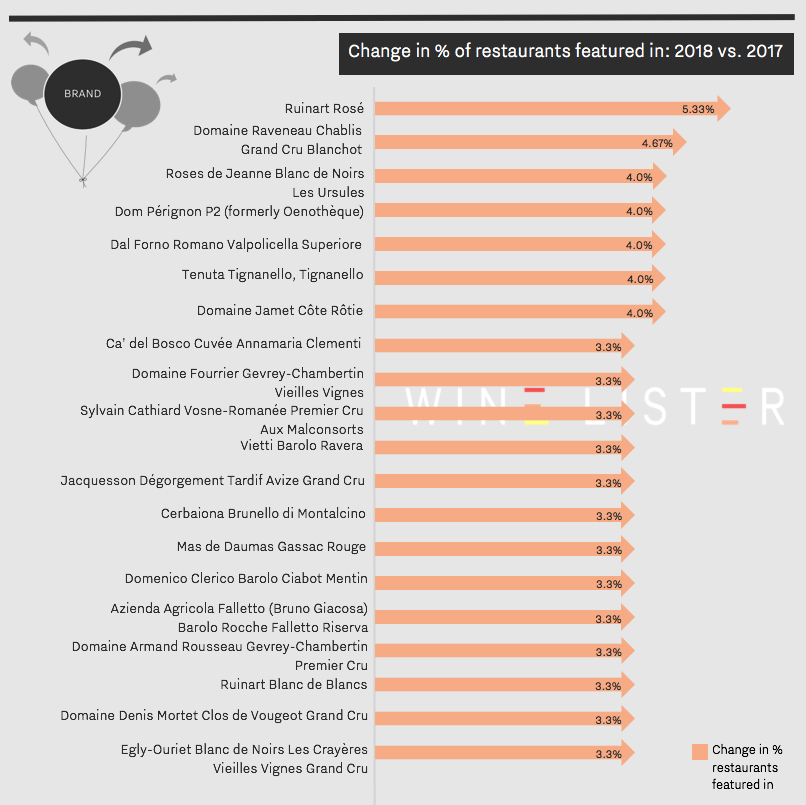
Six out of the 20 wines with the biggest increase in restaurant presence are Champagnes. Ruinart appears twice, with its NV rosé having made the greatest improvement, now appearing in 33% of the world’s best restaurants. However, the overall winner – present in more than double the number of restaurants, is Dom Pérignon’s Vintage Brut. Despite not featuring in the top 20 biggest risers above, the Champagne Brand king is now present in 69% of top restaurants worldwide, overtaking last year’s winner, Yquem.
Contrary to our last analysis on the subject, not all the biggest Champagne gainers in restaurant presence are big brands. Ruinart Rosé, Dom Pérignon P2, and Ruinart Blanc de Blancs may well fit this bill, with an average Brand score of 878, but the lesser-known three, grower Champagnes Roses de Jeanne Blanc de Noirs Les Ursules, Jacquesson Dégorgement Tardif Avize Grand Cru, and Egly-Ouriet Blanc de Noirs Les Crayères Vieilles Vignes, do not, as shown by a lower collective Brand score average of 664.
If this alone is not an indication of restaurant wine lists branching out, then perhaps the absence of Bordeaux is (indeed, a handful of Bordeaux wines with strong restaurant presence have lost a little ground since last year’s analysis). This diversification does however appear exclusive to the Old World, with no New World wines in the top 20 gainers.
Burgundy is well-represented amongst the top gainers, with one white, Raveneau’s Chablis Blanchot, and four reds: Sylvain Cathiard’s Vosne-Romanée Aux Malconsorts, Denis Mortet’s Clos de Vougeot, Armand Rousseau’s Gevrey-Chambertin, and Fourrier’s Gevrey Chambertin Vieilles Vignes.
Italy brings a show of diversity with six wines hailing from four different appellations across the 20 biggest movers. Vietti’s Barolo Ravera – one of three Barolos to feature in this list – has the lowest restaurant presence of the group (5%) and Solaia’s younger sibling, Tignanello the highest (47%).
As part of our Brand score, Wine Lister measures popularity using the three-month rolling average searches on the world’s most visited wine site, Wine-Searcher.
We have recently updated our treatment of this data to provide relative results for all 4,000+ wines on Wine Lister. Expressing each wine’s search frequency as a ranking will make it easier for our users to interpret the data. For example, Mouton is the #1 most searched-for wine of all wines on Wine Lister, according to monthly searches on Wine-Searcher.
To mark this transition, here we examine the top 50 most popular fine wines in the world.
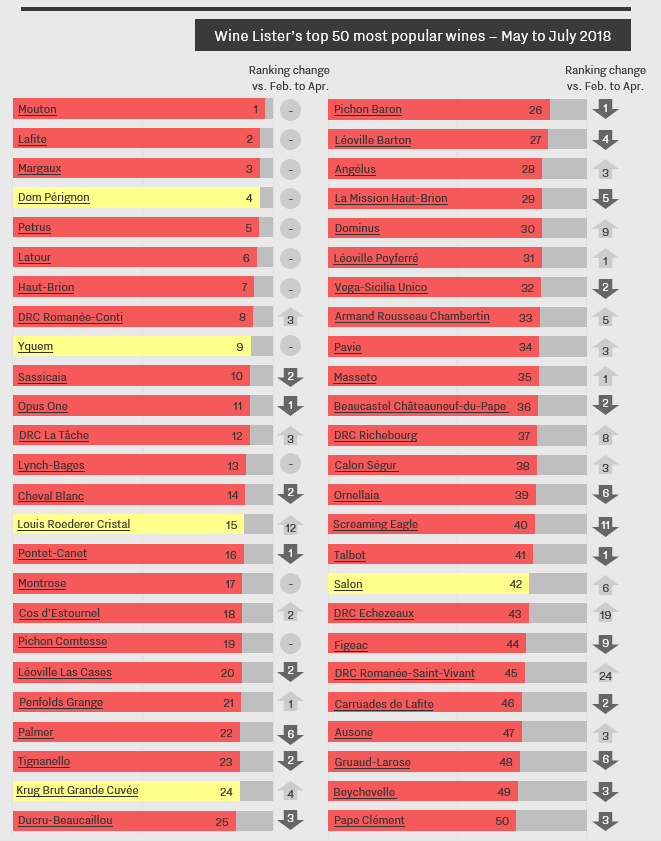
The first seven most searched-for wines for the period of May, June, and July include the five Bordeaux left bank first growths (Mouton, Lafite, Margaux, Latour, and Haut-Brion), right-bank powerhouse, Petrus, and Champagne super-brand, Dom Pérignon. It is perhaps of no surprise that these rankings remain unchanged since the previous period (February to April) .
Burgundian searches in the top 50 are dominated by Domaine de la Romanée-Conti, with Romanée-Conti, La Tâche, Echezeaux, and Romanée-Saint-Vivant all achieving better rankings versus the previous period. These four together achieve an average ranking of 30th place, and an average movement up the search ranking of 11 places.
Other than Dom Pérignon, the two remaining Champagnes featured in the top 50 most searched-for wines have moved up the rankings for May-July 2018 compared to the previous three-month period. Louis Roederer’s Cristal was up 12 places, presumably due to the release of its 2008 vintage in June. Krug’s most recent Grande Cuvée (166th edition) was released in late May, explaining its jump four spots up the rankings into 24th place.
More than half of the top 50 most popular wines are Bordeaux, with 30 wines hailing from the region. However, Bordeaux did not see the boost to their search ranking one might have expected during Bordeaux’s en primeur 2017, with one fewer of the region’s wines featuring in the top 50 than before the campaign kicked off. In fact, supporting Wine Lister’s analysis of this year’s lacklustre campaign, searches for many top Bordeaux châteaux actually fell during this period. For instance, Figeac, despite achieving Bordeaux’s 10th best Quality score of the 2017 vintage, slipped nine spots down the rankings.
Buzz Brands are wines that are sure to turn heads, destined to cause a stir whenever they are opened. They combine excellence across Wine Lister’s two Brand criteria – restaurant presence and online popularity – whilst also being held in the highest regard by the fine wine trade – as confirmed by Wine Lister’s Founding Members’ survey which gathers the opinions of around 50 key players in the international wine trade. This week, the Listed section focuses on Italy’s top five Buzz Brands by overall Wine Lister score.
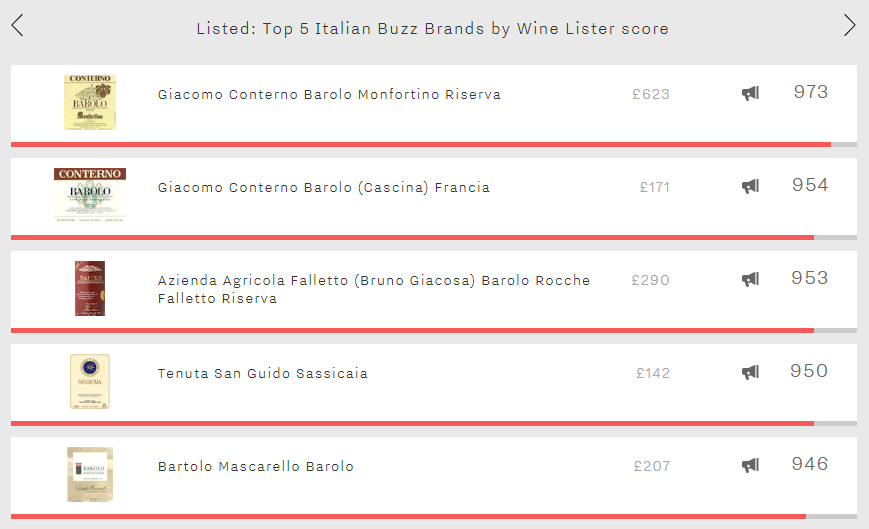
Barolo is home to four of Italy’s top five Buzz Brands, two of which are produced by Giacomo Conterno – the flagship Monfortino in first place (973) and Francia not far behind in second place (954). The Monfortino achieves Italy’s best Quality score (977), the result of remarkable consistency from vintage to vintage, having achieved a score of 993 or above in seven of the past 10 vintages. Its best ever vintage was 2004 (998), thanks to a perfect 100-point score from Antonio Galloni, who writes: “I imagine the 2004 Monfortino will give readers an utterly spellbinding drinking experience for the next few decades”.
Whilst the Francia is pipped at the post in each category by its illustrious stablemate (trailing by 17 points in the Quality category, 11 in the Brand category, and 34 in terms of Economics), it does manage superior restaurant presence, visible in 30% of the world’s top establishments, compared to the Monfortino’s 23%. This is presumably due to over three times as many bottles of it being produced each year on average.
In third place is Azienda Agricola Falletto’s Rocche Falletto Riserva (953). It records the best Economics score of the five (969) and Italy’s second-best, beaten only by Falletto’s Barbaresco Asili Riserva (978). It does so thanks to the combination of very strong growth rates – it has recorded a three-year compound annual growth rate of 21% and has added 8% to its value over the past six months alone – and strong liquidity – its top five vintages having traded 398 bottles at auction over the past year. Perhaps collectors have been eager to get their hands on a bottle after the passing of Bruno Giacosa in January.
Proving that Super Tuscans can mix it with Piedmont’s top nebbiolos, Sassicaia takes fourth place. Whilst it cannot keep pace with Barolo’s finest in the Quality and Economics categories, Sassicaia stretches out a comfortable lead in the Brand category thanks to an extraordinary score of 998. This near-perfect score puts it alongside Haut-Brion, Margaux, and Petrus, beaten only by the Pauillac First Growths, Dom Pérignon Vintage Brut, and Yquem. Its brand dominance is the result of outstanding restaurant presence (49%) and online popularity – receiving well over three times as many searches each month as Conterno’s Monfortino, which is the group’s second-most popular wine.
Rounding out the five is Bartolo Mascarello’s Barolo. Its brand is its strongest asset, its score of 964 making it Barolo’s second-strongest brand behind Conterno’s Monfortino. Despite receiving over 20% fewer online searches each month than the Monfortino, it matches its level of restaurant presence – perhaps the azienda’s famous “no barrique no Berlusconi” message strikes a chord with sommeliers.
As a sort of postscript to the difficult 2017 en primeur campaign (read our CEO Ella’s thoughts here), over the past week or so Pomerol powerhouses Petrus and Le Pin were released at £1,480 and £1,750 per bottle respectively. With Pomerol wines achieving the top three Quality scores of all reds for 2017 – and five of the top 10 – it was the top-performing red appellation of the vintage.
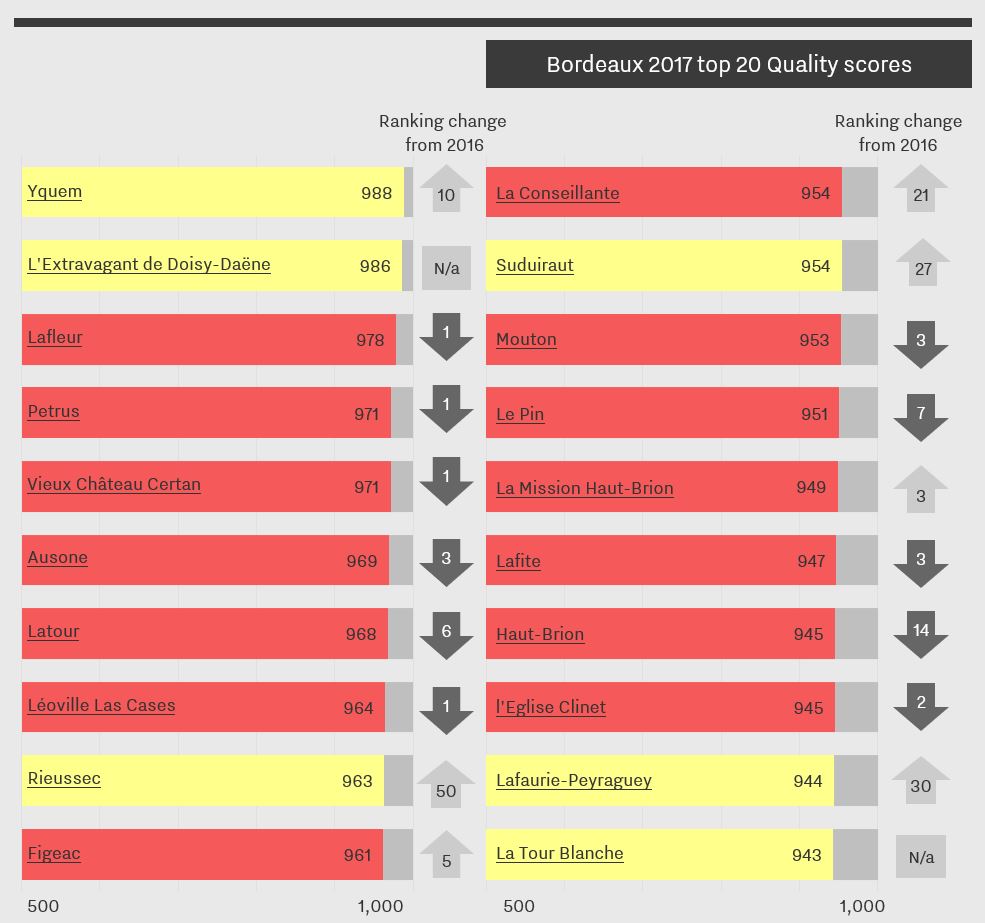
Now that we have release prices for all of Pomerol’s top wines, we can see which came out on top in terms of overall Wine Lister score*.
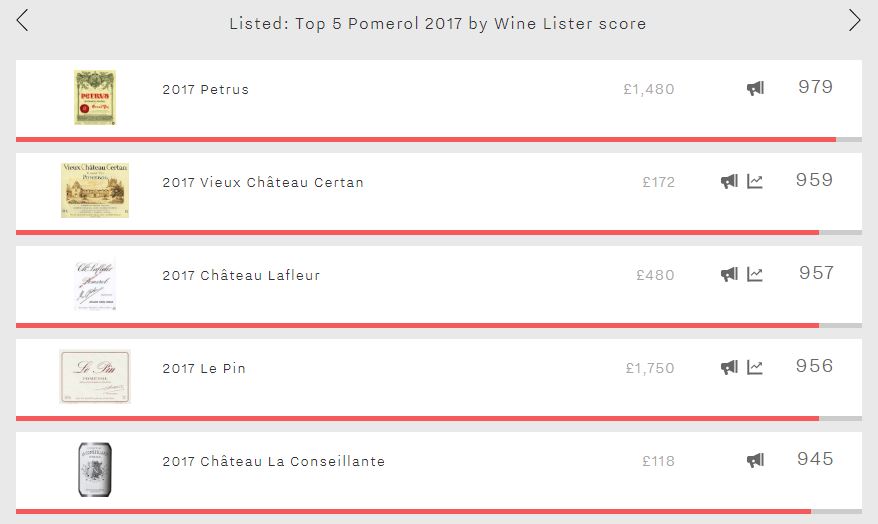
With a score of 979, Petrus was not just Pomerol’s leading wine of 2017, but the number one wine in Bordeaux. This is perhaps unsurprising given that it received the joint-second best Quality score of the vintage of all reds (971) – alongside Vieux Château Certan – and also has a Brand score of 998 (beaten only by Lafite, Latour, Mouton, Yquem, and Dom Pérignon Vintage Brut) along with a wine-level Economics score of 978 (third-best in Bordeaux). With Wine Lister’s Founding Members voting it the second-most prestigious wine in the world in a recent survey, behind DRC La Romanée-Conti, Petrus is currently unbeatable in Bordeaux.
Number two on the 2017 Pomerol leaderboard is Vieux Château Certan (959). While the confidence rating attributed by Wine Lister’s Founding Members slipped a point over the past year from 9/10 to 8/10, it nevertheless achieves Pomerol’s second-best Brand score (972). Thus, despite its relatively modest Economics score (909) – still putting it amongst the very best on Wine Lister’s 1,000 point scale – the 2017, thanks to its excellent Quality score, manages to edge just ahead of Lafleur in terms of overall Wine Lister score (957).
Lafleur 2017, the best red wine of the vintage for Quality (978), was released in early May at £430 per bottle, a 7% decrease on the 2016 release price. This was Neal Martin’s favourite of the five, Wine Lister’s newest partner critic awarding it a score of 95-97 /100 and commenting: “This is an awesome 2017 from Baptiste Guinaudeau, one of the few that will oblige several years in the cellar”.
Le Pin 2017 was released in the UK at £1,750 per bottle, its 25% decrease on the 2016 release price the largest year-on-year reduction of the five. It experiences the lowest Quality score of the five for the vintage (951), and also has the group’s lowest Brand score (944). The fact that the 2017 betters Lafleur and La Conseillante in terms of overall Wine Lister score is thus the result of its formidable Economics score (980), which it achieves not just because of its high average price but also strong growth rates, which are the best of the group over both the long and short-term.
Rounding out the group is La Conseillante (945). Whilst it is by far the most affordable of the group, it is the only one of the five whose 2017 climbed the Bordeaux Quality score table compared to 2016, surging 21 spots to be the eighth best red and 11th best overall.
Remember that you can catch up on all of the campaign’s releases on our dedicated en primeur page.
* Please note that overall Wine Lister scores for en primeur wines use estimated Economics scores based on the performance of back vintages.
While the jury is still out on pricing for Bordeaux 2017 (since the majority of key wines are yet to be released) Wine Lister can confirm, through scores from our partner critics, that the sweet whites from Sauternes and Barsac are some of the quality triumphs for 2017. The top five highest Quality scores for sweet whites all appear in the top 20 overall highest scores for Bordeaux 2017.
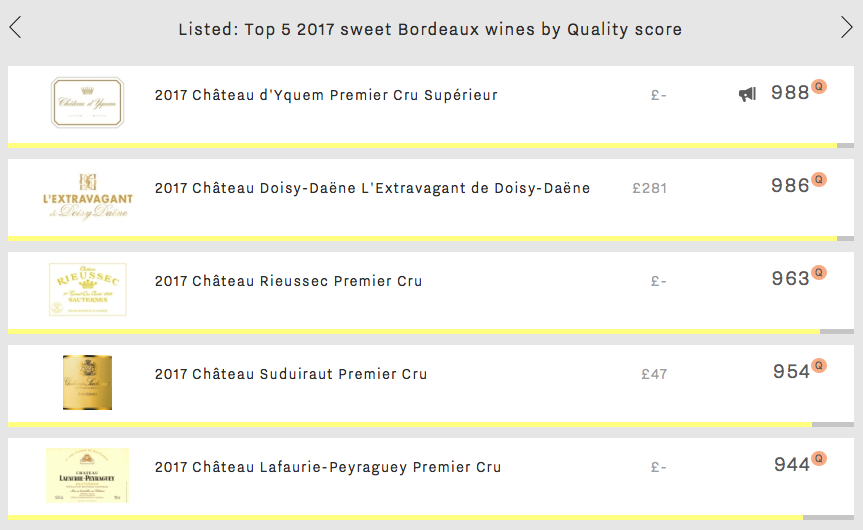
The highest Quality scorer not only for 2017 sweet whites, but for all 2017 Bordeaux is Château d’Yquem (988). Quality here is impressively consistent, with scores of 964-993 for the last 12 vintages (with the exception of 2012, when no wine was made for fear of compromising on quality following poor weather conditions throughout the growing season). Yquem is also a Brand tour de force, earning Wine Lister’s highest Brand score (matching Dom Pérignon Vintage Brut and three of the five red first growths, Lafite, Latour, and Mouton).
In second place, again not just for sweet white, but for Bordeaux 2017 in general, is L’Extravagant de Doisy Daëne. With a Quality score of 986, it is Wine Lister partner critic Antonio Galloni’s only potential 100-point scorer, earning 97-100 points and a laudatory tasting note; “…could very well turn out to be the wine of the vintage in Sauternes and Barsac…L’Extravagant is a total head-turner.” Doisy Daëne produced only 1000 37.5cl bottles of L’Extravagant this year (half their usual production level) – a fact that perhaps offers an explanation for the 2017 release price tag of c.£280 per 75cl, above current back vintages available on the market.
Suduiraut is Sauternes and Barsac’s third highest Quality scorer in 2017 (954). At wine level, Suduiraut performs better for Brand and Economics than L’Extravagant, and for a much lower price (£36 versus £256 on average per bottle). It benefits from presence in the world’s best restaurants and monthly online searches, both eight times those of L’Extravagant, no doubt due in part to production levels, which are 50 times higher.
Numbers four and five on this week’s top five list are Rieussec and Lafaurie-Peyraguey. Lafaurie-Peyraguey achieves its highest Quality score since 2007 (944). Rieussec’s Quality score of 963 places the 2017 vintage within reach of some of the greats for the domaine in recent years (namely 2015, 2009, and 2001). Its Quality strength is matched by a strong brand, benefitting from its place under the Domaines Barons de Rothschild umbrella.
However, like most Sauternes, its Economics score is weak. Rieussec does not have the best track record of price performance post-release (as seen on p.14 of our Bordeaux study), and this year released at €42 ex-négociant for the fourth consecutive year, above market prices for all recent vintages.
You can see more Bordeaux 2017 Quality scores on our en primeur page. Follow Wine Lister on Twitter for real time release updates throughout the Bordeaux en primeur campaign.
Unintentionally coinciding with today’s International Women’s Day – really, it was a complete accident – this week our Listed section looks at “pink Champagne”, namely the five most expensive rosé Champagnes. We are a bit embarrassed that it looks like we are jumping on the bandwagon and touting the colour pink today. However, as these five contenders show, top rosé Champagne represents a serious vinous offering worthy of any day or occasion.
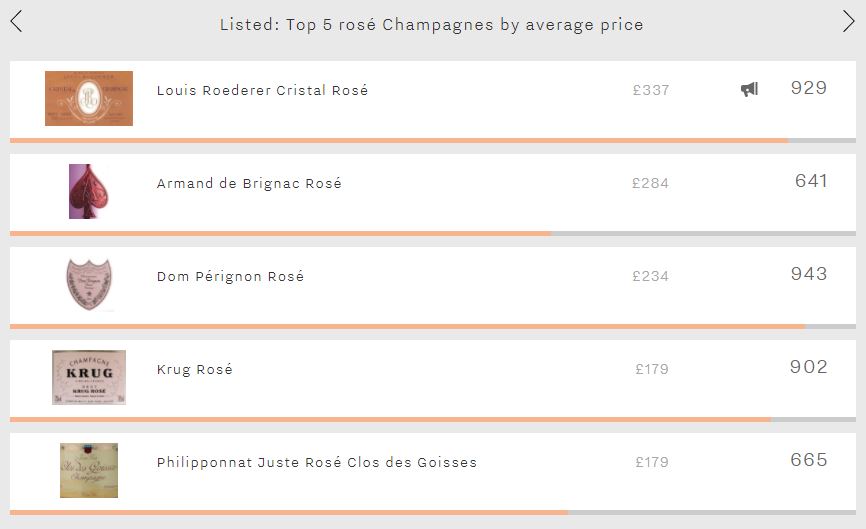
The world’s most expensive pink Champagne is Louis Roederer’s Cristal Rosé (£337 per bottle). It also achieves the highest Quality score of all rosé Champagnes (972). Whilst it receives excellent scores from each of Wine Lister’s partner critics, it is the outstanding average rating of 97/100 from Antonio Galloni’s Vinous that stands out. Cristal Rosé also pips its white counterpart to the post in the Quality category (972 vs 970), and is over twice as expensive (£337 vs £165 per bottle). However, despite its superior quality, Cristal Rosé trails its white counterpart in the Brand category by 56 points – it features on under half as many of the world’s top wine lists and is searched for 82% less frequently.
The second-most expensive rosé, Armand de Brignac’s offering, is a newcomer to the fine wine world, born in 2006. It experiences the group’s lowest Quality and Economics scores, and second-weakest Brand score. Its high price (£284) can therefore be attributed to its association with Jay-Z. The American rapper featured Armand de Brignac’s white Champagne in the video for “Show Me What You Got” in 2006 – before it even had a US importer – and eventually bought a significant portion of the house in 2014, further aligning the brand with his high-flying lifestyle.
In third place is Dom Pérignon’s rosé (£234). Whilst unable to match the peerless brand recognition of its white counterpart, it does enjoy the best Brand score of any pink Champagne (984). This is thanks to receiving on average 2.5 times as many online searches each month as the second-most popular wine of the five (Cristal Rosé).
The last two spots are filled by Krug’s rosé and Philipponnat Juste Rosé Clos des Goisses, each costing £179. The fact that the Krug enjoys a lead of 237 points in terms of overall Wine Lister score yet costs the same shows that when it comes to rosé Champagne, prices don’t always have a rational explanation. The chart below confirms a lack of correlation between price and overall Wine Lister score for these five wines.
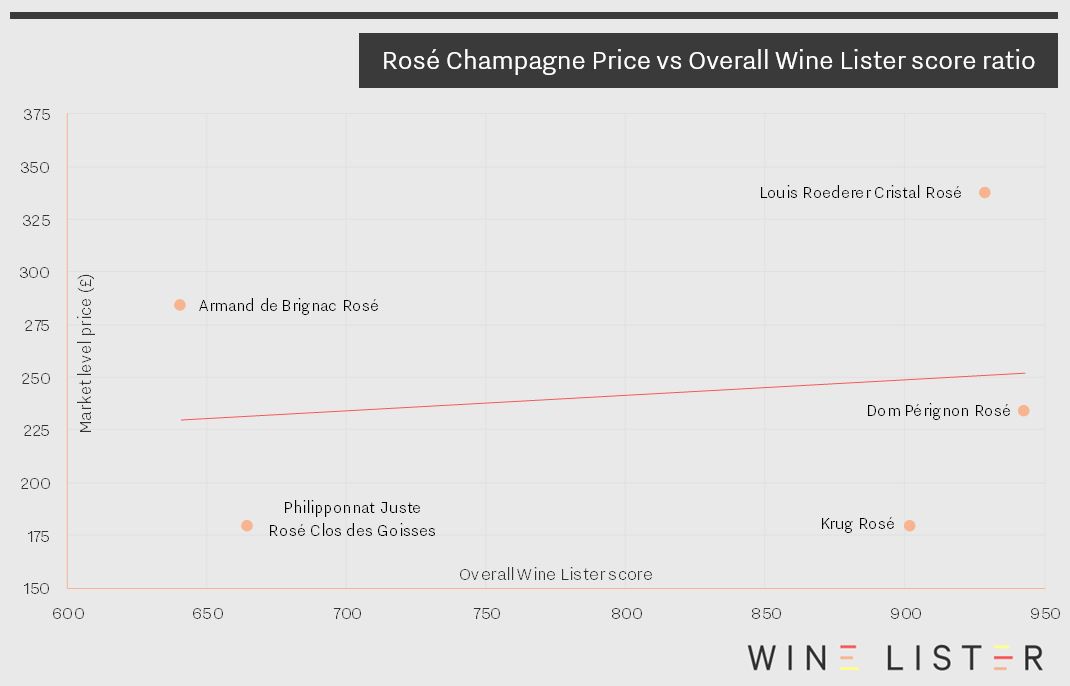
Wine Lister uses search frequency data from our partner, Wine-Searcher, to examine wines with increasing online popularity on a monthly basis. Wines with the highest search frequency numbers tend to be consistent, with the Bordeaux left bank premiers crus classés generally taking the top spots.
This month’s biggest search frequency gainers also rank as some of the most searched-for wines on Wine-Searcher. Dom Pérignon Vintage Brut is the third most popular wine with over 84,000 searches after Lafite and Mouton, closely followed by Petrus in fourth place. Armand Rousseau’s Chambertin and Moët & Chandon Grand Vintage appear in the top 50, while Azienda Agricola Falletto’s Barolo Rocche Falletto Riserva comes lower down at number 148 out of the circa 5,000 wines on Wine Lister, but its search frequency has recently increased by 15%.
Our last post on online search frequency revealed Wine Lister’s first ever perfect Brand score. Moving on from the Christmas period, Champagne brands still show marked increases in search frequency, but this time they do not stand alone at the top.
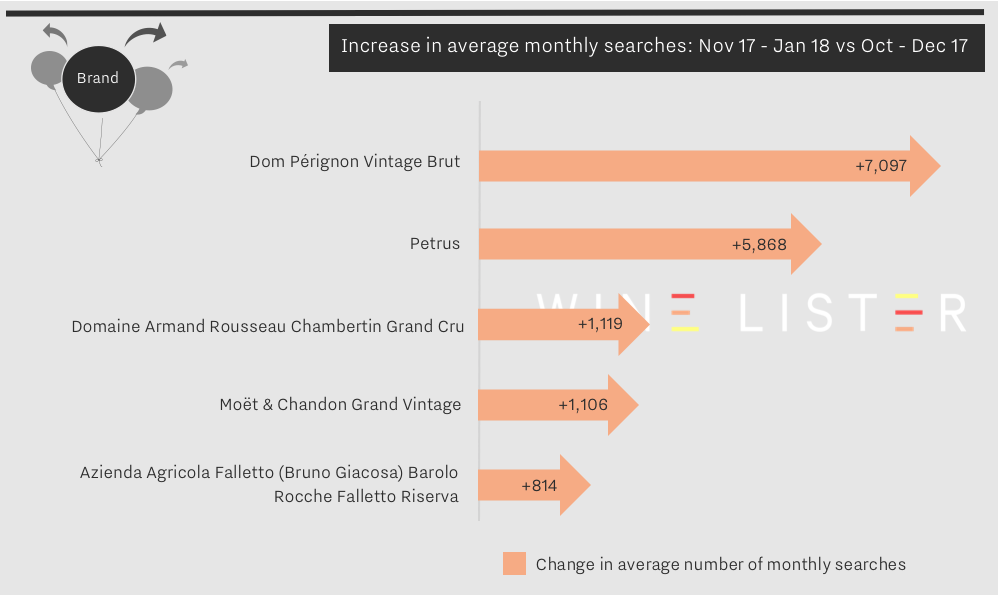
Dom Pérignon Vintage Brut is the largest gainer in popularity for the second time running. Increasing at a slower rate than in December, its popularity nonetheless grew by 7,097 searches into January, maintaining its 1000-point Brand score. Dom Pérignon remains the only wine to achieve a perfect score from any of the Wine Lister score categories. The other Champagne still riding high on searches is Moët & Chandon Grand Vintage, which increased by 6%.
Bordeaux creeps back onto the map for online searches at the beginning of 2018, with the first growths having featured heavily in searches up to December 2017. Petrus is in second place after Dom Pérignon, with an 8% increase in search frequency. It will be interesting to see if search increases for Bordeaux follow the same pattern as last year as we approach the 2017 en primeur campaign.
Armand Rousseau’s Chambertin appears in third place. Armand Rousseau was only one of two producers to achieve a perfect confidence rating from our Founding Members in our recent Burgundy study.
In fifth place for increased popularity is a bittersweet entry. Searches for Barolo Rocche Falletto Riserva from Azienda Agricola Falletto increased as the wine world learned of the sad passing in January of Piedmont legend, Bruno Giacosa. You can read more on Bruno Giacosa’s legacy in a recent blog on Barbaresco, here.













